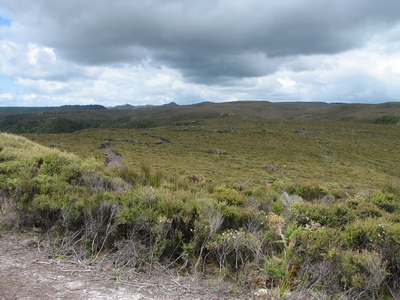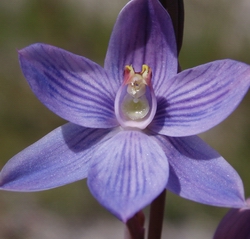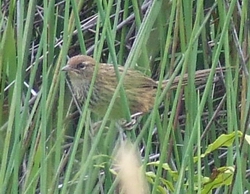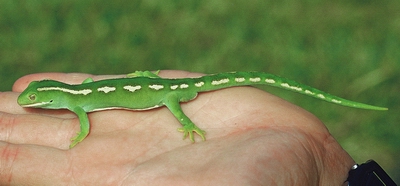Gumlands
What is a gumland?
Gumlands are similar to the pakihi wetlands found further south. They are the least fertile and most acidic of the wetlands and are normally found on gently sloping ridges where ancient kauri forests once grew. Over thousands of years the kauri dropped acid litter causing nutrients and organic material to leach out of the soil. This left behind a hard silica pan (base) which is a barrier to water draining away. Fires are a feature of gumlands causing further loss of nutrients. Gumlands are often not recognised as wetlands because they are on hilltops. In summer they can dry completely and in winter they may be water logged. They receive all of their water from rain. In hollows, wet peat bogs can form (see Bogs fact sheet).
 Epakauri Gumland south of Ahipara.
Epakauri Gumland south of Ahipara.
Why are gumlands so important?
Gumlands are uniquely associated with ancient kauri forests and help define the natural character of the Northland Region. They played a part in Northland's early European history drawing thousands of settlers to seek their fortune digging kauri gum from the gumfields. Gumlands are home to an unusual community of plants and animals that have adapted to survive in harsh, infertile environments, many of which are now rare. Once very common in Northland, most gumlands have been cleared and developed.
Vegetation
 Native striped sun orchid, Thelymitra pulchella. Gumland is often confused with scrub but a closer look will reveal a unique community of plants many of which are shared with the acid, infertile bogs.
Native striped sun orchid, Thelymitra pulchella. Gumland is often confused with scrub but a closer look will reveal a unique community of plants many of which are shared with the acid, infertile bogs.
Stunted, short manuka may be dominant. Schoenus brevifolius and Baumea sedges (wiwi), tangle fern (Gleichenia dicarpa) and Dracophyllum lessonianum can be abundant.
A search on the ground and along track edges will reveal a treasure trove of native orchids, tiny ferns and sundews, some of which are very rare.
Animals
 Although the wetland birds that use open water may not be present in this wetland type it does provide habitat for many forest bird species such as fantails and tuis.
Although the wetland birds that use open water may not be present in this wetland type it does provide habitat for many forest bird species such as fantails and tuis.
Gumlands are also prime habitat for the Northland green gecko, North Island brown kiwi and North Island fernbird. Black mudfish and endemic Northland mud fish sometimes live in wet hollows and gumholes.
 Northland Green Gecko (Photo: Richard Parrish, DoC).
Northland Green Gecko (Photo: Richard Parrish, DoC).
Looking after your gumlands
You may be eligible for a Northland Regional Council Environment Fund grant for up to 50 percent of the costs of wetland fencing, pest control and planting.
Nutrients
Gumlands are low fertility, acidic wetlands and are extremely vulnerable to increases in fertility and acidity (pH).
Changes in fertility will cause vegetation to change and pest plants to grow more easily, e.g. gorse, hakea, broom, woolly nightshade and acacia. Some weeds – such as gorse – fix nitrogen and increase soil fertility further, doing even more damage.
Prevent increases in fertility in gumlands by:
- Avoiding fertiliser drift;
- Avoiding lime fertiliser as this will increase the pH; and
- Controlling weeds which fix nitrogen – gorse, acacia (wattle), oxylobium and dally pine (Psoralea).
Plant pests
Gumlands, being a drier type of wetland, are very vulnerable to woody weeds, many of which are spread by fire. Avoiding fires, earthworks, drainage, and damage by vehicles or stock trampling will help prevent weed invasion. Weeds in the legume (pea) family such as gorse, acacia, broom and oxylobium fix nitrogen and increase soil fertility doing even more damage. Fires can help spread many of these weeds so they take over the native plants.
Please contact a Northland Regional Council Biosecurity Officer for advice and to apply for funding before you start weed control.
You can keep the weeds out by:
- Avoiding fires, earthworks or disturbance that will favour weed invasion;
- Fencing stock out to reduce disturbance and prevent weed spread;
- Washing equipment and farm machinery after working in weedy areas or off your land.
Hydrology (water levels)
Gumlands form on gently sloping ridges where ancient kauri forests once grew. Over thousands of years the kauri dropped acid litter causing nutrients and organic material to leach (wash) out of the soil leaving behind a hard, white silica pan (base). This pan set like concrete acting as a barrier to water draining away so a wetland formed on top. Because gumlands are on ridges and rely totally on rainfall they are usually parched dry in summer and saturated in winter. A layer of peat will usually form and permanently wet hollows may be peat bogs (see Bogs fact sheet). Destroying or ripping the clay pan that underlies the gumland with machinery will mean that the pan leaks water downwards causing the gumland to become drier in winter. The vegetation may then become weedy or change to shrubland.
Remember that before you do any works in a gumland you need to contact the Northland Regional Council, as you may need a resource consent.
Animal pests
When it comes to animal pests, there are some basic rules of thumb:
- Black mudfish and frogs can't cope with gambusia (mosquito fish) so make sure you don't introduce them.
- Wetland birds, lizards and invertebrates respond well to basic pest control.
- Pest mammals include rabbits, possums, stoats, weasels, ferrets, hedgehogs, rats and cats.
- Wandering dogs harass or kill native birds.
- Rabbits, in particular, browse the young stems of native orchids along tracks or open areas.
Basic predator control is as easy as a line of traps or bait stations along tracks or edges.
Contact a Northland Regional Council Biosecurity Officer for advice on the best pest control methods for your situation and whether you are eligible for funding.
Stock
Gumlands are a poor source of feed and stock do a lot of damage so it's not a good idea to allow them access or use gumlands as runoffs. Pugging breaks through peat in wetter hollows and stock browse softer plants. Farm animals can spread weeds or open up areas for weeds to move into.
Contact the Northland Regional Council for advice on fencing and how to apply for funding.
Ponds or dams
Earthworks are not recommended in gumlands as this will seriously damage their clay pan.
Please contact the Northland Regional Council for advice and before considering creating a dam or pond as you may need a resource consent.
